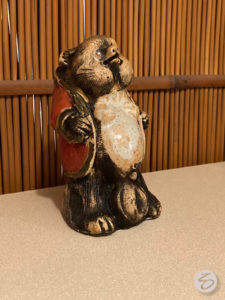Kōgō for Ro
Sen no Rikyū suggested that when using the fu–ro, 風炉, wind-hearth, the incense should be byaku-dan, with a kō-gō, 香合, incense-gather, made of wood and lacquered, and when using the sunken hearth, ro, 炉, the incense should be neri-kō, 練香, knead-incense, and a ceramic kōgō. There is no end to the variety of containers for incense for the furo and the ro.


















The tanuki is identified as a Japanese raccoon dog (Nyctereutes viverrinus), and is seen in the wild. Its name may be derived from ta-nuki, 田抜, rice field-plunder, appears to come from its damaging rice fields and crops. Japanese people see the tanuki as mischievous, and have put him as a welcomer to bars where figures of him are holding a tokkuri and tally of charges. Males are believed to be endowed with procreational prowess and images of him reveal his generative characteristics: however, the tanuki’s scrotum, kin-bukuro, 金袋, gold-bags, was a symbol of good luck and wealth, rather than sexual potency.
One of the most popular stories in Japan, is a folk tale titled, “Bun-buku Cha-gama,” 分福茶釜, Divide-fortune Tea-kettle. It is story of a tanuki transforming itself into various things, including a girl, a monk, a tea kettle, and a crowd-pleasing tightrope walker. There are countless versions, but there have been a multitude of kettles that have tanuki attributes. The scene was set at the Zen temple of Mo-rin-ji, 茂林寺, Luxuriant-forest-temple, established in 1426, is north of Tōkyō in a town called Bun-buku-chō, 分福町, Divide-fortune-town. As expected, the area is filled with thousands of ceramic statues of tanuki, and shops to purchase them. Many of the tanuki were and are made in Shiga-raki, 信楽, Faith-pleasure. The pictured tanuki was made in Iga, which neighbors Shigaraki.


Such objects that are made for a particular zodiac sign are called E-to kō-gō, 干支香合, incense-gather. E-to is the combined aspects of twelve signs of the Asian zodiac and the ten variations of the Go-gyō, 五行, Five-transitions, elements, which is called a sexagenary cycle of sixty years. The five elements are augmented by two, first and second, a kind of In and Yō, classified as older and younger brother. For example, the year I was born, 1938, was marked with Tsuchi-no-e Tora, 戊寅, Earth-’s older brother Tiger.
Shonzui was a 17th century Japanese potter, Go-ro-dai-yu Go Shon-zui, 五良大甫呉祥瑞, Five-good-great-first [Wu – area of China] Auspicious-omen, who took the name of a Chinese potter, Xián-gruì, 祥瑞, who had settled in I-se, 伊勢, That-energy. Such style called Shonzui were Chinese porcelain wares made for export to Japan. One observable difference between the styles of blue and white porcelains is that Shonzui style has more blue coloring.

